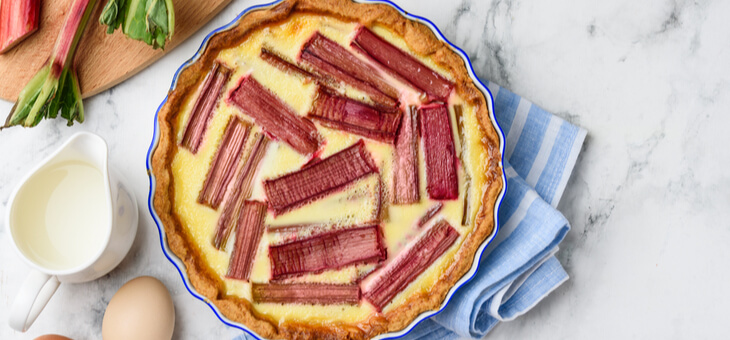It is possible to make this tart wheat free, dairy free and/or egg free depending on which pastry you use.
This is what I make the most – one piece of pastry rolled out with the edges folded over a mountain of gorgeous fruit. I prefer this to a fruit pie with top and bottom pastry, as the bottom pastry crisps wonderfully and you get more fruit and less pastry in each slice. It’s especially quick to put together if you already have pastry in the freezer. Almost any fruit, as long as it is ripe, is delicious in this tart.
Serves: 10–12
Ingredients
- 1 quantity classic sweet shortcrust pastry (or barley, spelt or coconut oil sweet shortcrust), rested and well-chilled
- 1 tablespoon raw or golden caster (superfine) sugar, extra, for sprinkling (optional)
Filling:
- 600g rhubarb, trimmed of leaves and bases, washed and cut into 2–3 cm pieces
- 500–600g ripe strawberries, hulled, washed and larger ones halved or quartered
- 55g (1/4 cup) raw sugar or 60ml (1/4 cup) maple syrup
- 2 tablespoons cornflour (cornstarch) or kudzu (kuzu), or spelt or wheat flour
Method
Preheat the oven to 200°C. Line a baking tray with baking paper. Roll out the pastry to a 30–35cm diameter circle (or smaller depending on the pastry you use). Move the pastry to the baking tray (I generally fold it) and centre it – depending on the size of the tray, it may overhang the sides a little. Don’t worry about that as you will be folding this over the fruit. If the weather is warm, or the pastry has softened, place it in the fridge at this point to chill while you prepare the fruit.
Place the rhubarb and strawberries in a bowl, together with the sugar or maple syrup and cornflour and toss through gently. Don’t do this step too early, as the juices will weep from the fruit and you want them to do this in the oven, where they will be immediately bound by the cornflour.
Remove the pastry from the fridge – it should be chilled but not so firm that you can’t fold the sides inward. If you do not already have a tray under the pastry, slide one under now.
Either arrange the prepared fruit in an attractive pattern, or simply pile it into the middle and gently spread to leave a border of about 8cm. Fold the pastry border over the fruit, peeling it from the paper underneath as you go. Try not to fold the pastry over itself as this gives you too many layers and it will not cook properly. Use kitchen scissors if needed to cut any pastry that is too wide. Sprinkle with the extra sugar if desired. If required, trim the sides of the baking paper to fit the tray. Place the tart in the freezer for 5–10 minutes to chill.
Place the tart in the oven. You can tell if your temperature is right by how the butter is behaving; if it is running out of the pastry, you need to turn it up – it should be sizzling on the pastry or at the base of it. Bake for 15–20 minutes before reducing to 180°C for about 35 minutes or until the pastry is lightly golden, and juices are bubbling, which indicates that the starch has cooked out. I also like to see that the juices have begun to ooze from the tart. If this has not happened, but the pastry is beginning to burn, reduce the oven temperature slightly. Don’t be worried if the juices look too watery, they will thicken a little as they cool.
Baking notes:
I’ve suggested you use 1–1.3kg of fruit. Be bountiful, and remember the fruit will cook down. I tend to use closer to 1kg when using winter fruits with less liquid in them (apples and pears) and more with the wetter summer stone fruits and berries.
You must always assess the amount of sugar and thickener you add to the fruit. Taste your fruit and see how sweet it is, adding between 1 1/2–3 tablespoons of sugar. Know also that fruits such as rhubarb will also require more. Wet fruit, such as stone and berries, especially, will require more flour/starch than dry winter fruits, about 1 1/2–2 tablespoons, but I tend to err on the side of less, preferring juice that is just bound, but runs.
Recipe and image from Wholefood Baking by Jude Blereau, published by Murdoch Books.

